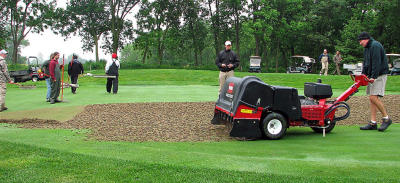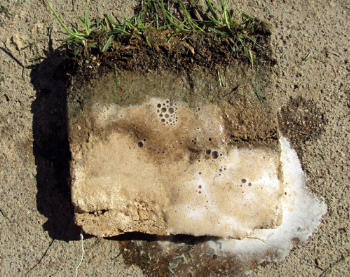The USGA Green Section
Record |
|
|
|
|
March 04, 2011 -- Volume 49, Number 9 |
|
| Putting Green Aeration | It is more important than you think
by Darin Bevard, senior agronomist, Mid-Atlantic Region |
 | |
No maintenance practice on golf courses receives more scrutiny and golfer ire than core aeration, and the role of aeration in the management of high-quality putting greens is often misunderstood. |
Harsh winter weather may lead to golfer requests to eliminate or reduce spring putting green aeration programs. The spring golf bug makes many golfers desperate to get out on the golf course. Snow cover, cold weather, and wet, sloppy conditions lead many courses to close for the entire winter in many areas. Golfers are anxious to try out a new driver or other equipment accumulated since the end of the golf season, and when the weather breaks, the golfers soon follow. Superintendents and their staffs are cleaning their courses and beginning to establish grooming programs for the growing season. As the weather warms, the grass starts to grow and the greens are ready to go. Golfer comments then follow: "Now the superintendent is tearing up the greens with core aeration and covering them with sand. Can't we just skip aeration since the greens are so good?"
Most commonly, golfer requests tend to range from eliminating core aeration from spring programs to, at least, reducing the size of tines and disruption created by the process. Eliminating or reducing spring aeration programs will not cause an agronomic catastrophe in the short-term, but it is important to realize why aeration is an essential process and to understand the ramifications of eliminating any planned aeration.
Read the entire article.
|
| Soil Testing Procedures For Calcareous Sands | |
Well-established soil testing methods on soils containing calcium carbonate or gypsum often underestimate fertilizer and soil amendment requirements. by Brian Whitlark, agronomist, Southwest Region |
 | |
When acid is placed on a soil containing appreciable calcium carbonate, the soil fizzes in the form of carbon dioxide gas bubbles. |
Imagine a scenario where you have been consistently collecting soil data for tees, fairways, and greens for more than five years, using one lab and one procedure. Does this sound familiar to you? If it does, great! Regular soil testing is an invaluable tool for developing and fine-tuning fertilizer and soil amendment programs. Receiving accurate and consistent values from the laboratory, coupled with personal observations, allows for intelligent decision-making in the field. But what if you were to discover that the data for all those years was wrong? Would you change to a more accurate procedure? If you grow turf on calcareous soils (those containing calcium carbonate) or gypsum, it is possible, and even likely, that you should consider changing soil testing procedures. However, in the absence of free carbonates or gypsum, a change in soil testing methods is unneeded. The objective of this article is to alert golf course superintendents who manage turf on calcareous or gypsiferous soils (containing gypsum in excess of 2%) that nutrient data obtained from the most commonly used and accepted soil testing extractants may result in misguided fertilizer and soil amendment programs.
Read this entire article.
|
| GCSAA Awards Education Points For Turfgrass Advisory Service Visits | Opportunities in the 2011 Turf Advisory Service
by the Green Section Staff | |
Golf course subscriptions to the USGA Green Section Turf Advisory Service (TAS) for the 2011 season are well underway. An exciting feature this year is the opportunity for golf course superintendents and assistants to apply for education points through the GCSAA. Participation in a USGA TAS visit at your course allows you to earn 0.3 (half day visit) and 0.6 (full day visit) points, respectively.
2011 TAS Fees:
Half-day visit: $2,400*
Full-day visit: $3,200*
Take advantage of the $600 discount offered to courses paying for a visit before May 15, 2011. The visit itself can be scheduled at any time during the season. Contact your regional agronomist today.
*Additional expenses may apply for courses outside of the United States.
|
| Tools Of The Trade | Purdue University posts useful on-line calculators
by Dr. Cale Bigelow, Department of Agronomy-Turfgrass Science | |
We have been working hard this winter to develop new and improved tools to help you be more efficient. These calculators are now available on the Purdue Turf Science website to help you address various turf-related questions.
An updated Turf Fertilizer Calculator
The calculator still allows you to compute granular fertilizer needs based on target nutrient rate and product analysis. It has been enhanced to help applicators interpret a fertilizer label and offers a new calculator to help determine liquid product needs. http://www.agry.purdue.edu/turf/fertilizerCalculator/index.html
A new Seed Calculator
This tool allows you to understand a seed label, calculate seed needs, and compare products. http://www.agry.purdue.edu/turf/seedCalculator/index.html
A new Sand Needs Calculator
This new tool helps turfgrass managers determine sand needs for topdressing, filling core aeration holes and sand bunkers. It was designed in response to the numerous questions regarding how much sand to use. http://www.agry.purdue.edu/turf/sandCalc/index.html
 | |
Screenshot of the Sand Calculator |
Purdue's turf program web site
|
| Green Section Regional Updates | |
 Northeast Region - 2011 March Madness Northeast Region - 2011 March Madness
by James Skorulski, senior agronomist
Golf courses are on alert to potential problems resulting from cold temperature injury. Golf courses located around metropolitan New York and some coastal New England golf courses experienced an ice event in early January, followed by a number of heavy snowstorms that left a more persistent snow pack than usual. Reports were heard that anoxic conditions (lack of oxygen) were evident below the ice, and there are now indications of some turf damage on plugs that have been pulled from greens. More recent rains have complicated the picture in some areas by exposing turf and creating some additional ice problems. | |
Read the rest of this update.
 Mid-Atlantic Region - Managing Expectations in 2011 Mid-Atlantic Region - Managing Expectations in 2011
by Darin Bevard, senior agronomist
The last Mid-Atlantic update was titled "What's Under All That Snow and Ice?" Warmer temperatures have allowed the question to be answered in much of the region. Overall, what we have seen and heard regarding putting green turf is positive. While it is too early to tell exactly how the grass will fare in the coming weeks, our opinion is -- so far, so good. That's the good news. The bad news is that another arctic blast sent temperatures into the low single digits in parts of the region. This is a cause for concern after the series of days that saw daytime temperatures in the 50's and 60's. Recent research on winter injury to Poa annua suggests that even a short period of warmer temperatures can rapidly reduce winter hardiness of this grass. As for creeping bentgrass, there is little concern for any winter damage on this more winter-hardy grass.
Read the rest of this update.
 North-Central Region - Transitioning North-Central Region - Transitioning
by R.A. (Bob) Brame, director
As we move from the harsh winter into the early spring season, golf courses throughout the lower North Central Region (Indiana, Kentucky and Ohio) are considering options for improving rough quality. For a significant number, the 2010 season and extended dry fall compromised rough density and prevented much-needed recovery prior to winter. Budgeting for added seed, fertilizer and labor will allow most to reestablish the desired quality prior to summer. That is, if reasonably-spaced spring rainfall cooperates.
Read the rest of this update.
 Southeast Region - Save These Dates Southeast Region - Save These Dates
by Patrick O'Brien, director, and Chris Hartwiger, senior agronomist
Plans are set for the 2011 USGA Regional Meeting on March 21-22, 2011. Co-sponsors of this meeting include the Carolinas Golf Course Superintendents Association, Carolinas Golf Association, and the South Carolina Golf Association. This meeting would be enjoyable for anyone associated with golf, including superintendents, club managers, golf professionals, golf course owners, architects, Green and Golf Committees, and any golfer interested in the topics.
See the line-up of speakers and register for this meeting
 Southwest Region - Color-Coded Calendar Helps Communicate The Impact Of Core Aeration On Greens Southwest Region - Color-Coded Calendar Helps Communicate The Impact Of Core Aeration On Greens
by Pat Gross, director
Busy organizations rely on a carefully coordinated calendar of events to meet the needs of their customers and avoid conflicts. This is especially true when it comes to golf courses and the need to coordinate maintenance activities with a busy tournament schedule. One of the most contentious issues is scheduling core aeration and coordinating this activity with the various special events at the course.
Most golf courses have adopted the recommended practice of establishing dates for core aeration at least one year in advance and then scheduling tournaments and special events after the agronomic calendar is established. Although they see the dates for aeration on the calendar, golfers don't know how long it will take for the greens to 'get good again'. Claremont Country Club in Oakland, California, developed a simple color-coded calendar that provides a visual indication of the relative putting quality following disruptive maintenance practices such as core aeration.
See the calendar and read the rest of this update.
|
| Green Section Record Archive (digital) | Looking for a previous issue of the Green Section Record?
|
 | |
Looking for something? |
The Green Section Record has been published under various names since 1921 and is composed of an amazing collection of full-text articles and photos. This collection is stored and maintained by the wonderful library staff at Michigan State University in the Turfgrass Information File (TGIF). All past issues of the Record, right up to and including this one, can be accessed free-of-charge by following this link. Search the Green Section Record |
| The USGA Green Section Portal |
A Valuable, Free Resource |
Take a minute to visit the Green Section's portal at http://gsportal.usga.org to find information regarding upcoming live webcasts and links to recordings of more than 30 previously-delivered webcasts and announcements of upcoming USGA Green Section activities, education conferences, and meetings. |
|
|
|
| USGA Green Section
P.O. Box 708
Far Hills, NJ 07931-0708 908.234.2300
| |

©2010 by United States Golf Association®
Permission to reproduce articles or material in the USGA Green Section Record is
granted to newspapers, periodicals, and educational institutions (unless specifically
noted otherwise). Credit must be given to the author, the article's title, USGA Green
Section Record, and the issue's date. Copyright protection must be afforded. To reprint
material in other media, written permission must be obtained from the USGA. In any
case, neither articles nor other material may be copied or used for any advertising
promotion, or commercial purposes.
Green Section Record (ISSN 2156-5813) is published weekly via electronic mail by the
United States Golf Association®, Golf House, Far Hills, NJ 07931.
|
|
|
|
|
|